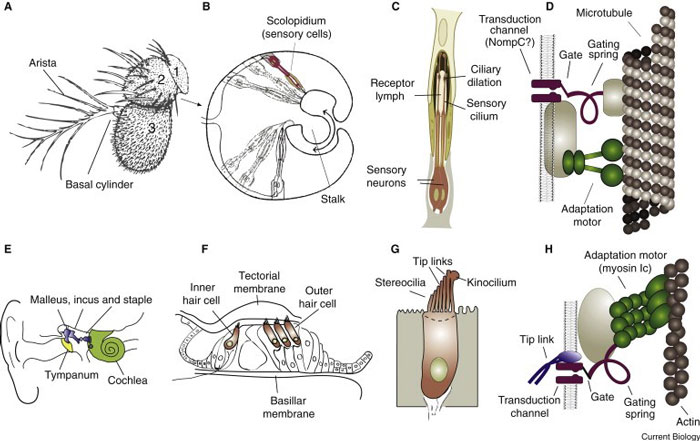Drosophila in Auditory Research
Drosophila auditory neurons were shown to be physiologically and genetically similar to the hair cells of the vertebrate cochlea. This discovery illustrates the great potential of Drosophila to study auditory transduction, cell development and the etiology of human deafness diseases. Therefore more and more scientists are turning to Drosophila hearing models with great success. Here, we briefly introduce the application of the Drosophila model in studying auditory neural circuits and hearing cell regeneration.
Applications in Auditory Neural Circuits
An important area of auditory research is the mapping of the neural circuits that transduce and process auditory information. In recent years, Drosophila models have made significant progress in revealing the nature of auditory neural circuits, which is an excellent start to understanding the developmental and specific mechanisms of auditory neural connectivity, sensory information processing, and behavior.
The auditory receptor neurons of adult Drosophila, also known as Johnston's organ (JO) in the pedicel of the fly's antenna, a tentacular chordotonal organs of approximately 225 scolopidia, function in hearing, gravity, and wind perception. Studies have shown that key developmental genes and structural components are conserved from the Drosophila JO to the mammalian ear. Thus it can be used for human auditory diseases gene discovery. Drosophila has been used to test genetic mechanisms known to be important for human hearing, such as crinkled/myosinVIIA and diaphanous.
In addition, similar to vertebrates, Drosophila auditory neurons are mechanoreceptors, capable of converting sound waves into electrical signals. By performing membrane clamp whole-cell recordings of Drosophila auditory neurons, scientists revealed that the TRPV channel NAN/IAV is the pore-forming subunit of MET channels in Drosophila auditory neurons, and that Drosophila auditory transduction channels in sensory neurons are very sensitive to mechanical force stimuli compared to the tactile transduction channels NompC and PIEZO, which are similar to vertebrate auditory transduction in this respect, implying that Drosophila auditory system are of high value for human auditory studies.
 Fig.1 Vertebrate and invertebrate ears (Bechstedt et al. 2008)
Fig.1 Vertebrate and invertebrate ears (Bechstedt et al. 2008)Application in Auditory Regeneration
Not only can Drosophila be applied to the study of auditory receptor circuits, it has been found that the auditory development model provides many insights into the regeneration of mammalian auditory cells.
Deafness and hearing loss are currently a hot topic in both fundamental research and Medicine. Since auditory and vestibular mechanosensory hair cells do not regenerate after injury or aging in the adult mammalian inner ear, this leads to irreversible hearing loss and balance disorders for millions of people. It is estimated that one-third of people will lost hearing or balance by age 80. Scientists urgently need regenerative strategies to restore hearing and vestibular function. However, mammals show sparse regenerative capacity in the cochlea, causing huge costs and technically challenging using those models at genetic, cellular, circuit, and behavioral levels.
In this context, some scientists chose Drosophila as an in vivo platform to understand and promote mechanosensory cell regeneration. In 2013, it was found that the molecular basis of noise damage to hearing in Drosophila was similar to that in humans, suggesting its potential as a model for hearing damage research. Besides, approximately 20% of genes abundantly expressed in the Drosophila JO were later found in human as homologs associated with deafness, as well as a subset of functions in multiple sensory modalities. More recently, scientists identified self-regenerative mechanisms in JO neurons which also can be enhanced by drugs. The exciting finding demonstrated that the Drosophila high-throughput platform can assess the functional regeneration of sensory cells at genetic, neural circuit and behavioral levels, as well as a great addition to the field of regenerative medicine.
CD BioSciences has decades of experience in Drosophila neuroscience. We are able to provide comprehensive scientific services for auditory disease mechanisms and regeneration to clients worldwide. Please feel free to contact us for discussing your project and creating a custom quote.
References
- Bechstedt S, et al. (2008). Hearing mechanics: a fly in your ear. Curr Biol, 18(18):R869-R870.
- Albert JT, et al. (2015). Hearing in Drosophila. Current opinion in neurobiology, 34, 79–85.
- Li B, et al. (2021). Nanchung and Inactive define pore properties of the native auditory transduction channel in Drosophila. PNAS, 118(49).
- Fernández-Hernández I, et al. (2021). Mechanosensory neuron regeneration in adult Drosophila. Development, 148(5), dev187534.
For research use only. Not intended for any clinical use.
Related Services
